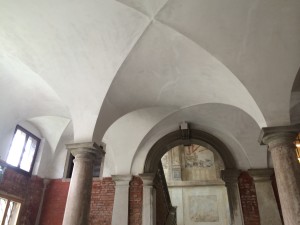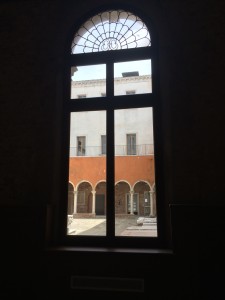On a canal in Venice last month, I got to see another “public ends, private means” project that’s gone from concept to brick-and-mortar reality. Or in this case, brick and mortar and marble reality.
The project, We Crociferi, provides high quality, low cost housing for students and other university-linked visitors in crowded Venice for 10 months each year. Using a rehabilitated 14th century convent, We Crociferi leverages income from tourists and study-abroad groups during the peak summer months to balance the bottom line without any public operating subsidies. 
At first, I viewed the project with delight rather than diligence. I dropped all my intellectual curiosity and just wandered around. This was Venice, after all, and you quickly get used to the notion that all kinds of amazing things may be down the next alley, across the next bridge, behind that heavy wooden door. We Crociferi lives up to those expectations, from quiet courtyards to soaring ceilings. Not to mention a dramatic space to be used for a revenue-producing restaurant and event space. Then the intellectual curiosity kicked in. Four things jumped out at me:
- This is real. I’ve heard about the project through its evolution from concept to empty hulk to launch, but it’s different when you see one of these projects alive and in person.
- This is sustainability in practice. The parent Oltre Venture group sees social, economic and environmental needs as interrelated, not competing goals to trade off against each other. The objectives are unmistakably social and economic. The building itself is a marvel of adaptive reuse.
- This is “public ends/private means” in practice. While the goals may reflect the triple bottom line, the project is run with the rigor and flexibility required to meet the real financial bottom line. This is a professional business operation.
- This takes a lot of clever brains, diligent hands and patient wallets. In Venice, that includes patient, responsible private capital investing on the operating side (Gastameco), in turn working hand-in-hand with public resources (Ministy of Education, Universities and Research) and other private sources (Fondazione Venezia) in the restructuring of the building itself.
 There’s also tremendous opportunity to leverage lessons across very different public-private projects. For example, this creative reuse of a convent in Venice for housing looks awfully different from the creative reuse of a food-truck commissary in Malden. But there are some interesting shared challenges such as:
There’s also tremendous opportunity to leverage lessons across very different public-private projects. For example, this creative reuse of a convent in Venice for housing looks awfully different from the creative reuse of a food-truck commissary in Malden. But there are some interesting shared challenges such as:
- Being different things to different people with integrity. These are complex projects that create financial sustainability through innovation and leverage. In Malden, that means simultaneously being a service provider, an economic development incubator, an employer, and an educator. In Venice, it means serving dramatically different markets during the year with very different needs, while also building out the restaurant and other opportunities.
 Filling and managing a wide range of different, overlapping roles while running a thin organization. In each project, there are important roles for the entrepreneur, the investor, hands-on project managers, and content experts (in hospitality, food service, etc.).
Filling and managing a wide range of different, overlapping roles while running a thin organization. In each project, there are important roles for the entrepreneur, the investor, hands-on project managers, and content experts (in hospitality, food service, etc.).
- Being accepted by a community at the same time that you’re practicing disruptive innovation. These projects are about change (or they’re not worth doing). Change inevitably disrupts somebody else’s life, business, neighborhood. Each of these projects has to pursue its disruption without being rejected by its neighbors.
I’m looking forward to visiting more public-ends/private-means projects. I expect to learn a lot and share those learnings. But Venice is going to be hard to top. 
[Scott Nadler is a Senior Partner at ERM. To share this post, see additional posts on Scott’s blog or subscribe please go to snadler.com. Opinions on this site are solely those of Scott Nadler and do not necessarily represent views of those quoted or cited, ERM, its partners or clients]

